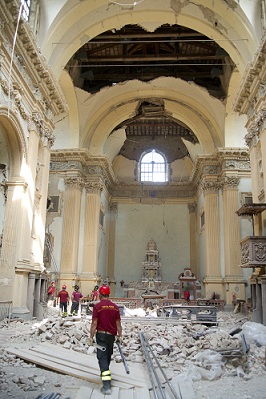A global team working on an earthquake early-warning system for Europe

Related topics
Environment & climate action Innovation France Germany Greece Italy Netherlands Romania Iceland Switzerland Environment Norway Egypt Japan Taiwan Turkeydate: 12/02/2014
Project: Seismic early warning For Europe
acronym: SAFER
See also: CORDIS
Contact: http://www.saferproject.net/
This initial ground wave travels very fast and arrives tens of seconds to minutes earlier than the main, destructive wave. The intensity of this initial ground vibration will indicate the destructive power of the earthquake. But what is more important is that these seconds and minutes allow people to protect themselves or reach safety. The activation of early-warning systems can also mitigate the impact of an earthquake by shutting down railways, gas pipes, and even nuclear power plants.
Started in 2006 and coordinated by the GeoForschungs Zentrum (GFZ) in Potsdam, Germany, researchers from 19 European institutions were part of the SAFER project team. Also participating in the project were researchers from four institutions in Japan, the United States, Taiwan and Egypt.
"The main aim of the project was to develop a novel, early-warning capability for Europe using the initial, information-carrying wave produced by earthquakes," says Gasparini.
Yih-Min Wu who is Associate Professor of Geosciences at National Taiwan University participated in many SAFER meetings with the aim of introducing new methods to the project and sharing experiences with his European counterparts. “We analysed strong motion records from Southern California, Japan, and Taiwan and estimated intensity from various seismic waves to achieve the earthquake early-warning system,” he says. “Our work was the foundation of the early-warning system and nowadays many European institutes use this approach,” he adds.
Demonstrator projects were set up in Istanbul, Bucharest, Naples, Athens and Cairo. In Bucharest a warning system is already operational in the city, while in Istanbul such a system is implemented for the bridge spanning the Bosphorus.
The prototype warning systems developed by the SAFER project team consist of networks of seismic stations placed near fault zones. Each seismic station is equipped with seismometers and accelerometers that detect ground vibrations. The latter, low-cost instrument is comparable to the accelerometer that triggers the inflation of the airbags in cars during a collision. These stations are linked via wireless systems to a processing center where the data is analysed, leading to a real-time assessment of the strength of the earthquake. If the earthquake presents a danger, warnings are issued and actions to stop trains and close down industrial installations are taken automatically. “For example, Naples is protected by a prototype system consisting of 30 seismic stations placed around the fault zone under the Appenines, 80 km east of the city,” reports Gasparini.
An important result of SAFER is that it has primed the European research community for just this type of research. "We have developed a real network of international experts, that have worked together for several years and together have gained valuable experience," comments Gasparini.
The development of response strategies to earthquakes, which was not part of the SAFER project, is now the focus of a current project called REAKT (Strategies and tools for Real-time EArthquake risK reducTion) that will deal with people' responses.
In particular, REAKT explores how to use the information coming from earthquake forecasts, early warnings and real-time assessments of the vulnerability of built structures. All this information will be combined in a probability framework that will be used by emergency managers to make decisions in real-time. This system for risk reduction will be applied to vulnerable infrastructures, including trains, hospitals, bridges, and schools. REAKT will also study possibilities for forecasting earthquakes. "For example, the detection of moderate seismic activity or ground deformation can indicate an increase in the probability of a pending earthquake," concludes Gasparini.
